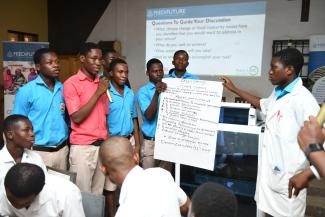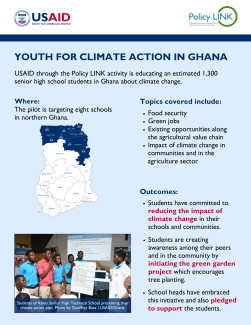
Geoffery Buta for USAID/Ghana
OVERVIEW
Climate change threatens Ghana’s future economic and human development. Higher temperatures, erratic rainfall, frequent and severe drought, land degradation, and water scarcity threaten food security, reduce incomes and standards of living, and weaken health systems. Recent information from the Ghana Statistical
Service indicates that 7.3 million Ghanaians are multidimensionally poor and, according to the World Bank’s Ghana Country Climate Development Report (2022), without urgent action, climate change will put one million more Ghanaians at risk of falling below the $2.15/day international poverty line by 2050.
Agriculture yields and labor productivity are also projected to drop and incomes could fall by up to 40 percent in the poorest households. USAID is working with the government, private sector, and local communities to reduce Ghana’s contribution to climate change and adapt to its impacts.
PROGRAMMATIC FOCUS
● Increasing agricultural yields by supporting certified seed producers and Ghanaian research centers to develop stress-tolerant, climate-smart seed varieties for increased production.
● Enhancing communities’ disaster preparedness b y collaborating with climate information service providers to establish systems for monitoring and analyzing disaster risk, providing early warning and facilitating efficient responses to climate-related disasters.
● Reinforcing climate-informed health surveillance and early warning systems.
● Reducing emissions and strengthening early warning systems by establishing shea parklands and parkland management committees that protect against encroachment, increase shea tree populations, and enhance the presence of fire-resistant tree species around the parklands.
● Encouraging climate financing to mobilize resources for climate action, implement Nationally Determined Contributions, increase private sector interest in climate-smart agriculture, and develop voluntary carbon markets
PROGRESS HIGHLIGHTS/ACHIEVEMENTS TO DATE
● Supported the Ghana Meteorological Agency (GMET) to develop a legal framework for regulating climate information. The National Framework on Climate Services now delivers timely and accurate weather information to stakeholders in the agriculture, health, disaster management, water, and energy sectors.
● Climate-smart agriculture interventions have increased the proportion of locally produced, certified hybrid maize seeds from 10 percent to 48 percent.
● Trained over 1,000 community-based advisors to support and sell seeds and other inputs to farmers. This has improved smallholder farmers’ access to climate-smart technologies and improved yields for more than 400,000 smallholder farmers.
● Mobilized approximately $56 million in climate financing for adaptation and mitigation, agroforestry initiatives, climate-smart agricultural inputs for farmers, making climate/weather information accessible, and reducing post-harvest losses and waste.
● Trained about 600 community members and natural resource management committees across 10 communities in the Northern Region on best practices for community shea parkland conservation and management.
● Provided $100,000 in immediate assistance and $500,000 in school supplies for victims of the Akosombo dam spillage.
● Supported the Ghana Health Service with over $1million medical equipment including non-mercury measuring devices to prevent harmful environmental releases and human exposure in accordance with the Minamata Convention.
OBJECTIVES IN 2024
● Increase the resilience of vulnerable populations such as smallholder farmers to climate impacts.
● Sustain climate financing efforts to reduce carbon emissions and improve climate resilience.
● Provide emergency support and coordinate with humanitarian and development partners to address climate crises.
● Increase awareness among young people on the impact of climate change, how to reduce their carbon footprint and opportunities for green jobs and agribusiness.
● Increase awareness and resilience within the population about risks of new diseases facilitated by climate change
● Partner with subnational health management teams to plan for extreme weather conditions, such as flooding.
● Continue to align with USAID'S Climate Strategy (2022–2030).


